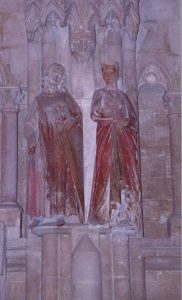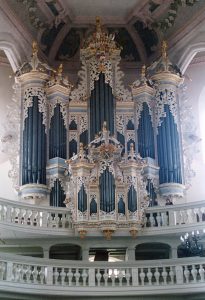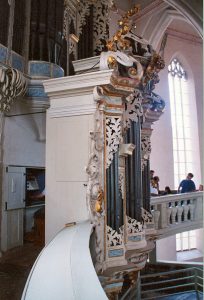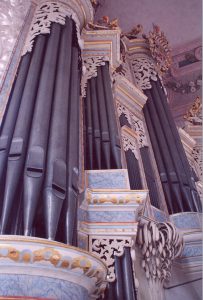Historic Organs of Germany
Naumburg
June 18, 2003
 Our final organ visit began with a walk through Naumburg to the Cathedral, one of the very few churches in Europe with a Chancel and altar at both the East and West ends of the Nave. The older West chancel is stark and very medieval in its appearance, as you can see from these two sculptures—two of the many that surround the altar.
Our final organ visit began with a walk through Naumburg to the Cathedral, one of the very few churches in Europe with a Chancel and altar at both the East and West ends of the Nave. The older West chancel is stark and very medieval in its appearance, as you can see from these two sculptures—two of the many that surround the altar.
 Our real reason for visiting Naumburg was, of course, the recently restored Hildebrandt organ in the Wenzelkirche. We heard Frau Organistin Irene Greulich play a short public recital at Noon, which gave us a good chance to hear the colors of this instrument as well as hear the effect of the unusual floor plan on the sound of the organ. The instrument is in a second gallery at the West end, not an unusual placement at all.
Our real reason for visiting Naumburg was, of course, the recently restored Hildebrandt organ in the Wenzelkirche. We heard Frau Organistin Irene Greulich play a short public recital at Noon, which gave us a good chance to hear the colors of this instrument as well as hear the effect of the unusual floor plan on the sound of the organ. The instrument is in a second gallery at the West end, not an unusual placement at all.
The building is wider at this point, however, than it is further along. In fact, about half the length of the building, the half closest to the organ, is around twice the width of the other half. This means that there are walls opposite the organ, extending from each of the side walls for one-fourth the width of the room, placed in such a position that part of the sound of the organ is reflected back before it has reached the other end of the room. The sound is then also reflected (later) from the remainder of the length of the room. The result is a longer, more complicated reverberation than one would expect to find in a room of this overall length and height.
 The sound of the instrument itself is glorious, with a “weighty brilliance” to the choruses. The pedal reeds seemed to be a little less dominant than those of the Silbermann organs we had heard, but the manual trumpet had all the depth and strength one could hope for.
The sound of the instrument itself is glorious, with a “weighty brilliance” to the choruses. The pedal reeds seemed to be a little less dominant than those of the Silbermann organs we had heard, but the manual trumpet had all the depth and strength one could hope for.
It was niether choruses, flutes, nor reeds, but the sound of the strings—all of them—that grabbed my attention. They were real strings, not Cavaillé-Coll Gambes, of course, but strings with a speech characteristic derived from a well-bowed violin, a sustained sound that was penetrating without being grating, and of enough variety and in sufficient numbers to make me want to play a transcription. Any transcription. The Rückpositiv Viol di Gambe led the way, and I expected it to be what it was, but I was not prepared for the beauty of the ensemble, nor for the clarity imparted to the bass line by the two violons.
I was quite simply blown away.
 In addition, the Unda maris was enough to send me over the edge. I felt at home!
In addition, the Unda maris was enough to send me over the edge. I felt at home!
After the recital, Frau Greulich invited us to the gallery, and while the church was closed to visitors, we were allowed to play until 2:00. Knowing that this instrument was played by Bach in 1746, that he was responsible for choosing the builder, and that he consulted both with Hildebrandt and with Joseph Altnikol, his son-in-law and organist there, in the selection of stops, we all found this final organ visit of our tour to be particular moving.
 One of the highlights of our time was Susan Fleming’s singing of an aria from a Bach cantata, with accompaniment provided by two organists working together to play the transcription at sight. The sound of the instrument, using some of the string stops, of course, in combination with the uintadena and a couple of flutes, was really quite convincing.
One of the highlights of our time was Susan Fleming’s singing of an aria from a Bach cantata, with accompaniment provided by two organists working together to play the transcription at sight. The sound of the instrument, using some of the string stops, of course, in combination with the uintadena and a couple of flutes, was really quite convincing.
All in all, the trip had been successful. We had heard and played several different types of instruments, both old and new, we had experienced German hospitality in every place, and we had enjoyed each other’s company and music-making. On the long bus ride to Frankfurt and our flight home, we swapped addresses, made plans to share photographs, and indulged in amore than a few “pipe dreams” about our next trip.
Journal Entry
Naumburg was impressive in nearly every respect. The Dom was medieval in its grandeur, complete with dark aisles, a crypt that proved frightening to me, and a neatly enclosed courtyard off the entryway. The Wenzelkirche was an amazing experience. To play that impressive organ was a dream come true, but I found other treasures inside the church that were equally impressive. On either side of the altar were two Lucas Cranach paintings. Lucas Cranach had been artist to the Ducal House of Cleves in Western Germany during the middle part of the 16th century, and his works are very humanist, thus reflecting the trend of the time he lived. In fact, Cranach was one of the artists selected by Henry VIII of England to paint a portrait of Anne of Cleves, who would become Henry’s fourth wife. Seeing his paintings of Christ and the Holy Family in the Wenzelkirche impressed me, because I had of course read much about Cranach in German history class.
I also had a breakthrough today—although Judy was the one who shed light on the subject—throughout the trip, I had been searching, in vain, for silver or gold charms for my bracelets. That afternoon, before we departed for Frankfurt, Judy handed me the cutest silver charm depicting the Dom and crest of Naumburg. I have already added the charm to my bracelet, and it serves as a great reminder of a truly fabulous trip!
